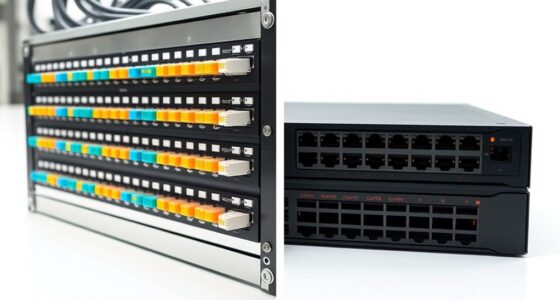Wireless standards like Wi-Fi 5, 6, and 7 offer faster speeds, better device management, and improved coverage for your wireless devices. They support IoT, enhance security, and reduce latency, making them ideal for flexible setups. In contrast, Ethernet provides a stable, high-speed connection with lower latency and less interference but limited mobility. To understand how these technologies compare for your needs, explore how advancements shape modern networks.
Key Takeaways
- Wi-Fi 5, 6, and 7 are wireless standards offering increasing speeds, efficiency, and coverage, while Ethernet provides stable, wired connections with consistent high performance.
- Wireless standards support mobility, IoT integration, and easier setup, whereas Ethernet ensures low latency and reliability for high-bandwidth tasks.
- Wi-Fi 7 aims for higher speeds and better spectrum utilization than Wi-Fi 5 and 6, but Ethernet typically offers faster, more consistent data transfer.
- Wireless signals are vulnerable to interference and security risks, while Ethernet connections are less prone to interference and generally more secure.
- Future trends include Wi-Fi advancements supporting immersive tech and IoT expansion, with Ethernet continuing to serve high-performance, wired network needs.
Overview of Wireless Standards: Wi-Fi 5, 6, and 7

Have you ever wondered how Wi-Fi standards have evolved to deliver faster and more reliable connections? Each new standard, from Wi-Fi 5 to Wi-Fi 7, improves device compatibility and spectrum management. Wi-Fi 5, or 802.11ac, introduced broader channels and higher data rates, enhancing streaming and gaming. Wi-Fi 6, or 802.11ax, further optimizes spectrum management by using OFDMA, allowing multiple devices to share channels efficiently, reducing congestion. Wi-Fi 7 aims to push these boundaries even further, supporting higher bandwidths and better spectrum utilization. These advancements guarantee your devices work seamlessly together, providing smoother connections and better performance. As standards evolve, high refresh rates become more important for real-time activities like gaming and streaming, and compatibility becomes more universal, and spectrum management becomes smarter, meaning fewer dropped connections and faster data transfer for you. Additionally, ongoing innovations in wireless technology contribute to the continual improvement of network reliability and speed.
Key Features and Technological Advancements

Building on the improvements seen in recent Wi-Fi standards, each generation introduces key features that enhance performance and user experience. These advancements include:
- IoT integration, allowing seamless connection of smart devices and improved automation. This integration often requires robust connectivity standards to support numerous devices simultaneously. Efficient network management is vital for maintaining performance as the number of connected devices increases. Additionally, the evolution of Wi-Fi standards reflects ongoing hardware advancements that enable faster and more reliable connections.
- Enhanced power efficiency, reducing energy consumption for devices and prolonging battery life.
- Advanced modulation techniques and higher bandwidth, supporting more data and better stability.
- Support for multiple device connections through improved headphone pairing capabilities, ensuring stable audio streaming. Additionally, these standards incorporate security enhancements to protect data integrity and user privacy.
These features enable your network to support smarter homes, more reliable connections, and longer device operation. Wi-Fi 6 and 7, in particular, focus on optimizing power efficiency to benefit battery-powered IoT devices. As a result, you experience more efficient connectivity, reduced energy costs, and a future-proof infrastructure that adapts to growing technological demands.
Performance and Speed Comparisons

How do the latest Wi-Fi standards compare regarding performance and speed? Wi-Fi 6 and 7 substantially boost bandwidth capacity, allowing faster data transfers compared to Wi-Fi 5. This means you can stream 4K videos, play online games, and transfer large files more smoothly. Ethernet connections generally offer higher consistent speeds and lower latency performance, making them ideal for activities requiring real-time responsiveness. While Wi-Fi standards improve, they still face challenges like interference and signal congestion, which can impact actual performance. Wi-Fi 7 aims to close the gap further, delivering even greater bandwidth and reduced latency. Overall, Ethernet provides more reliable speed and lower latency, but advanced Wi-Fi standards offer impressive performance that can meet most daily needs without wired connections.
Reliability, Security, and Interference Considerations

Wireless connections can be affected by various factors that impact their reliability and security. Interference sources like neighboring networks, physical obstructions, and electronic devices can disrupt signals. To improve stability, interference mitigation techniques are essential, such as channel selection and signal filtering. Security protocols like WPA3 help protect your data from unauthorized access. Consider these key points: 1. Interference from other wireless devices can cause drops and slowdowns. 2. Proper interference mitigation ensures a more stable connection. 3. Implementing strong security protocols safeguards your network against threats. Additionally, understanding the types of wireless standards can help optimize your network performance and compatibility. Being aware of diverse device designs and features, such as those found in different wireless standards, can further enhance network efficiency and security. For example, newer standards like Wi‑Fi 6 and 7 incorporate advanced modulation techniques that improve data throughput and reduce latency in congested environments. Recognizing the compatibility requirements of various devices can also help in selecting the most suitable standard for your setup.
Advantages and Limitations of Wireless vs. Wired Connections

While wireless connections offer the convenience of mobility and easy setup, they often face limitations in speed, stability, and security compared to wired options. Wireless mobility lets you move freely without physical constraints, making it ideal for devices like smartphones and tablets. However, Wi-Fi signals can be affected by interference, distance, and obstacles, which reduce speed and cause connection drops. Wired connections, on the other hand, provide wired stability that ensures consistent, high-speed performance, especially for demanding tasks like gaming or large data transfers. While wired setups are less flexible and require physical cables, they deliver reliable performance and enhanced security. Additionally, ongoing research into AI vulnerabilities highlights the importance of robust security measures for all network types. Your choice depends on whether you prioritize convenience and flexibility or need maximum stability and speed for your network. Furthermore, advancements in automation technology are enhancing wired network infrastructure, improving reliability and security features. For applications requiring consistent bandwidth, wired connections often outperform wireless options, especially in environments with high interference.
Future Trends and Evolving Network Technologies

Advancements in network technologies are rapidly shaping the future of connectivity, making networks faster, more reliable, and more secure. Emerging 5G technology will boost speeds, reduce latency, and support massive device connections. IoT integration will expand, connecting everything from smart homes to industrial systems seamlessly. As these trends evolve, you’ll see:
- Enhanced 5G networks enabling real-time data processing and low-latency applications.
- Widespread IoT adoption transforming industries with smart devices and automation.
- New network standards prioritizing security, scalability, and energy efficiency to support future demands.
These developments will revolutionize how you work, communicate, and interact with technology, creating a more interconnected world that adapts to your needs.
Frequently Asked Questions
How Do Wireless Standards Impact Device Battery Life?
Wireless standards directly impact your device’s battery life by influencing battery consumption and power efficiency. When you use newer standards like Wi‑Fi 6 or 7, they optimize data transfer and reduce power usage, helping your device last longer. Conversely, older standards may drain your battery faster due to less efficient data handling. Choosing devices with advanced wireless standards can markedly improve your battery life and guarantee more power-efficient connectivity.
Can Wireless Standards Support All Types of Smart Home Devices?
Wireless standards are like a universal translator, but they can’t speak every smart home device’s language perfectly. While Wi-Fi 5, 6, and 7 support many smart home compatibility needs, some wireless device limitations still exist, especially with low-power sensors or devices needing constant connection. So, not all smart home devices can be supported seamlessly, and you might face compatibility challenges depending on your network and device types.
What Are the Environmental Impacts of Deploying Wireless vs. Ethernet Networks?
Wireless networks generally have lower energy consumption per device, reducing environmental impact, but they may generate more material waste due to frequent upgrades and device replacements. Ethernet cables and hardware tend to last longer, minimizing waste, but they involve manufacturing and installation energy. Overall, wireless deployments can be more eco-friendly initially, yet ongoing upgrades might increase waste, so balancing energy use and material waste is key for sustainable network choices.
How Do Wireless Standards Affect Network Scalability in Large Enterprises?
You might think wireless standards limit scalability, but they actually support it by enabling flexible network density and spectrum management. Wi-Fi 6 and 7 support more devices simultaneously, reducing congestion in large enterprises. As a result, you can expand your network without sacrificing performance. This adaptability ensures your infrastructure scales efficiently, accommodating growing demands while maintaining reliable connectivity across extensive environments.
Are There Compatibility Issues Between Older Devices and Newer Wi-Fi Standards?
You might encounter device compatibility issues when connecting older devices to newer Wi-Fi standards, but most modern Wi-Fi standards include standard backward compatibility. This means your older devices should still work, although they may not benefit from the latest features or speeds. Keep in mind, some very outdated devices may struggle or require firmware updates to guarantee seamless connectivity with newer Wi-Fi standards.
Conclusion
Understanding wireless standards like Wi-Fi 5, 6, and 7 helps you make informed choices for your network needs. While wireless offers unmatched convenience, it’s not without its pitfalls. Sometimes, a wired Ethernet connection is the best bet for speed and reliability—truly, it’s the best of both worlds. Keep an eye on future advancements to stay ahead of the curve, because in tech, it pays to be prepared rather than caught off guard.








